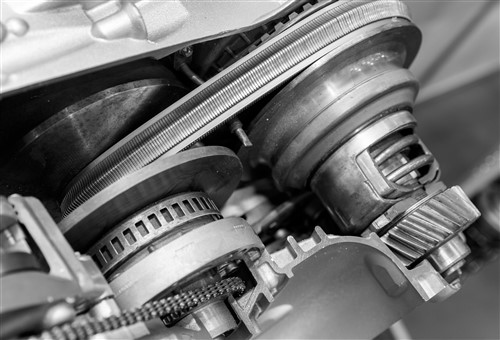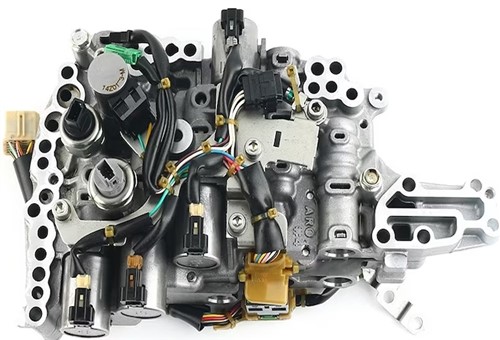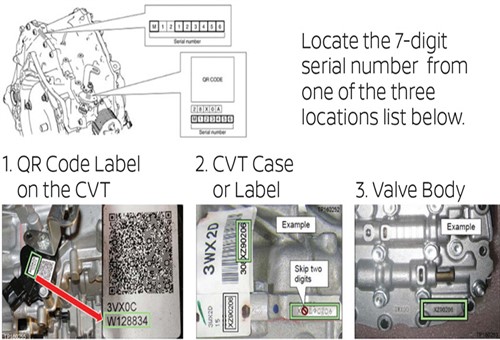
In two previous articles on Nissan CVT transmissions, we discussed the basic operating principles of these transmissions as well as the importance of performing some service procedures correctly to forestall the possibility of comebacks and damage occurring to these transmissions. Now, in this article, we will discuss some things to look out for when you need to perform some types of repairs or programming of Nissan CVT transmissions. Let us start with-
A few months ago, the owner of a small two-mechanic workshop invited this writer to consult on the possible reasons why the new CVT transmission in their customer’s 2016 Nissan Juke made a load rumbling noise when the transmission was in gear with the engine running, but with the drive wheels lifted off the ground.
According to the workshop owner, they had never owned a CVT-equipped vehicle before, and the only reason why they bought this Juke was because a) it was a low-mileage car for its age, and b) the CVT transmission was new, the original unit having been replaced by a Nissan dealership with a new unit a few weeks before they bought the vehicle privately.
In case you are not aware, many CVT-equipped Nissan Juke and Qashqai models suffer from a condition in which the engine begins to stall progressively more often at low speeds until the engine stalls every time it runs at low speeds. The root cause of this problem is an internal bearing that begins to collapse, which then blocks an oil passage, thus causing extensive damage to some of the transmission's internal components due to a lack of lubrication.
Although this problem was repairable* when the original CVT transmission in the Juke failed, the vehicle’s then owner opted to have the transmission replaced instead of repaired before selling the vehicle.
* Although this particular failure mode qualified as a known pattern failure, it took Nissan several years to develop reliable repair options.
Long story short, though, the small workshop was doing a simple oil change on the engine, and it was during an inspection for oil leaks while the vehicle was on a hoist that the owner of the workshop noticed that the new CVT transmission was very noisy if the driveline was engaged with the engine running. The vehicle's owner was then notified of the faulty transmission. However, the vehicle's owner then insisted that the workshop obtain a second opinion on the problem because as far as they were concerned, the CVT transmission worked flawlessly and did not make any noise when they drove the vehicle.
When this writer arrived at the small workshop, the Juke was still on the hoist, but the noise he heard coming from the transmission was familiar. It was a deep rumbling sound he had heard many times before on Nissan CVT transmissions, but it was also perfectly normal. The only strange thing was that neither the owner of this workshop nor his employee had ever heard it before, but that is a story for another time.
However, since the workshop's owner did not seem to think that a noisy new Nissan CVT transmission could be normal, he had already made arrangements with a specialist transmission repairer to repair the new transmission- at huge expense to the vehicle’s owner.
To counter this unnecessary expense to the vehicle’s owner, this writer dug up a Nissan TSB (NTB16-109b, dated May 17 2018), which applies to all CVT-equipped Nissan models. This TSB is too long to reproduce here, so we will only quote one relevant section directly from this TSB as published on the website of the National Highway Traffic Safety Administration, a US Government agency-
“SERVICE INFORMATION - With the engine running and the vehicle on a hoist, noise heard from the CVT may be louder (in Park, Neutral, Drive, or Reverse) than a non-CVT type transmission. CVT transmissions are much louder without [a] drive load, which may lead to misdiagnosis.
Do NOT judge CVT noise as abnormal due only to noise on a hoist (with or without the wheels turning). “ (Italics added)
We can end the story of this consultation here, but it is important to note the following two points-
So, the moral of this story is this: you can save yourself a lot of diagnostic time and your customer a lot of potentially unnecessary expense simply by familiarising yourself with the content of Nissan’s NTB16-109b, which includes a handy diagnostic chart/tree when you encounter a noisy Nissan CVT transmission.
Nonetheless, Nissan CVT transmissions do have other problems you need to be aware of, so let us look at-

Image source: https://i.etsystatic.com/22482629/r/il/daf8e2/3400126019/il_794xN.3400126019_k07g.jpg
While shift solenoids in Nissan CVT transmissions fail for largely the same reasons that shift solenoids in conventional automatic transmissions fail, mechanical failures of CVT transmissions are almost always not only near-catastrophic, but also near-prohibitively expensive to repair. In fact, in most cases, replacing a failed Nissan CVT transmission with a used unit is far more cost-effective than repairing a CVT transmission that has suffered mechanical damage.
Nonetheless, replacing either a valve body or a complete Nissan CVT transmission requires retrieving calibration data that must be programmed into the transmission control module after erasing the current calibration data. Here is how this works, but be aware that what follows is the generic version because the required reprogramming procedures depend on both the nature of the failure and the version or variant of the affected transmission. Let us start by looking at-
Valve body replacements
Since it is impossible to produce shift solenoids that are identical in both dimensional aspects and operating characteristics, the performance, unique operating characteristics, and physical properties of shift solenoids are measured and programmed into the transmission control module of each CVT-equipped vehicle during the vehicle’s manufacturing process.
This information forms a substantial part of each CVT transmission’s calibration data. Note, though, that although there are sometimes slight differences between how identical CVT transmissions in identical vehicles respond or react to calibration data under similar inputs or operating conditions, TCMs of CVT transmissions are programmed to accommodate the effects of a range of manufacturing tolerances and operating characteristics of Nissan CVT valve bodies.
Put differently, the above means that since there are meaningful differences between the operating characteristics of a well-used CVT valve body and a new CVT valve body, it is crucially important that the TCM be programmed with the calibration data that is supplied with the new valve body to ensure that the CVT transmission works as both designed and intended.
As a practical matter, you will need the transmissions’ serial number to access currently stored calibration data with Nissan’s CONSULT III software. If you have access to this software, and depending on the CVT version or variant, you can find the transmission’s serial number in one of the three possible locations as shown below-

Image source: Nissan North America, Inc
Transmission Control Module Replacement
Note that since the calibration data for each Nissan CVT valve body is unique, replacing a Nissan CVT control module requires that the currently installed valve body’s calibration data be retrieved from the old TCM before the new TCM is installed. This information must be written to the new TCM to preserve the operating characteristics of the CVT transmission.
However, depending on the nature of the TCM failure, it may not be possible to retrieve this data from the old TCM, but in these cases, the required calibration data is available on Nissan's official tech support website, which brings us to-
Although Nissan was the first car manufacturer to develop a CVT transmission that could handle the power and torque of a 3.5L V6 engine, this application of CVT transmissions is plagued by serious problems.
For example, many late-model CVT-equipped Nissan models with V6 engines are particularly susceptible to judder complaints/issues. In Nissan-speak, a judder is a severe vibration, shake, or shudder with either a single or multiple "bumps" or vibration cycles. In many cases, this condition is accompanied by either, or sometimes both, Nissan-specific trouble codes P17F0 or P17F1.
As with many other Nissan-specific codes, the definition(s) of these two codes do not provide much information beyond referring to issues with the CVT transmission’s drive belt. Nonetheless, Nissan has released two TSBs that address this issue: the first is NTB17-039M, which runs to 116(!) pages and describes the CVT belt inspection procedure in excruciating detail. The other TSB, NTB15-014, is only 12 pages long and describes CVT reprogramming procedures that will usually, but not always, resolve codes P17F0 and P17F1.
NOTE: Although several high-end generic scan tools can perform reprogramming or relearning procedures on Nissan CVT transmissions, you might encounter glitches or other programming issues with non-Nissan-specific software and equipment. Therefore, we highly recommend that you use Nissan's CONSULT III software to reprogram Nissan CVT transmissions and control modules because Nissan provides several helpful step-by-step tutorials and specific programming tips in several TSBs (and other official Nissan sources) that apply to their CONSULT III software.
On a purely practical level, though, the presence of either or both codes P17F0 and P17F1 on a V6-equipped Nissan vehicle usually means that there is a strong possibility that the vehicle's CVT transmission cannot be repaired economically. The other side of the problem is that it could take more than two full days (or sometimes longer) to work through a 116-page TSB while trying to pinpoint the cause of the judder complaint- and then still not be sure what’s causing the issue at the end of two (or more) days worth of work.
The point of the above is this: if you encounter codes P17F0 and P17F1 on a late model Nissan vehicle with a V6 engine and a CVT transmission, the wisest course of action would be to refer the affected vehicle to a Nissan dealer or a specialist transmission repairer with experience in resolving codes P17F0 and P17F1 on late-model Nissan vehicles. This is because a) you need a large number of Nissan special tools and equipment to remove and disassemble the transmission, and b) you need to know and understand what you are looking at when you insert a borescope into the transmission to inspect the drive belt and pulleys.
While point “a” might be doable, point “b” only becomes possible with long experience in diagnosing internal CVT transmission issues, which is something not many of us have, thus leaving us with this-
Although it is often possible to diagnose most issues and failures on modern Nissan CVT transmissions accurately, fixing issues and failures on modern Nissan CVT transmissions is another matter entirely. Apart from the fact that one needs many special tools to perform some repairs, the main problems with fixing Nissan CVT transmissions are that a) one needs lots of OEM service and repair information to perform most repairs, and b) one also needs Nissan-specific software to perform most repair and relearning procedures.
Overall, Nissan CVT transmissions are unlike any other transmissions you have ever worked on and embarking on major repairs of these transmissions should not be undertaken lightly. We are not suggesting that you should always shy away from diagnosing and repairing modern Nissan CVT transmissions- far from it. What we are saying, though, is that you should never jump to conclusions or draw hasty diagnostic inferences when you encounter noisy or suspect CVT transmissions on Nissan vehicles.
The best thing to do when you encounter a noisy or suspect CVT transmission on a Nissan vehicle is to gather as much information on the affected transmission as you can before you do anything else. Drawing hasty conclusions about issues on Nissan CVT transmissions rarely ends well so if you have to read through dozens of freely available Nissan TSBs, including this one about CVT fluid level checks, consider this time well spent. Not spending this time might very well cause you to fall into a (deep) diagnostic rabbit hole that you might not be able to get out of with your reputation and sanity intact.
Despite the above, there is no need to fear Nissan's CVT transmissions- they are just like many other technologies we have had to learn to understand, but tread very lightly around these transmissions when you deal with them to avoid making potentially hugely expensive diagnostic mistakes.